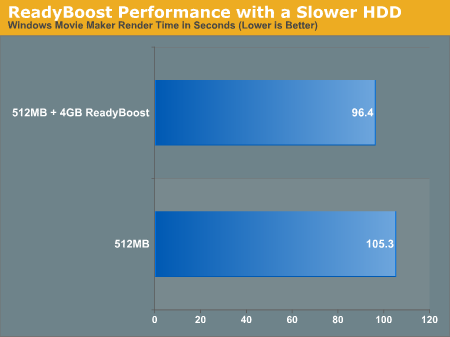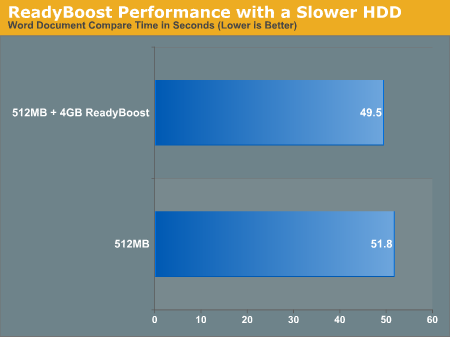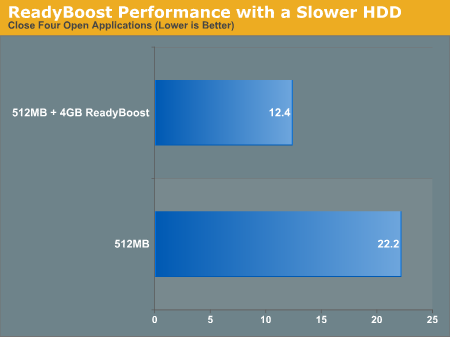Impact of Drive Performance on ReadyBoost
For our ReadyBoost tests we used a modern hard drive, a Western Digital 500GB drive. We wanted to find out if ReadyBoost had an even greater impact if your system has a slower drive, so we switched to a five-year old Western Digital WD1000 100GB drive to see how ReadyBoost's impact changed, if at all. We took three benchmarks - the Movie Maker, Word, and Application Close tests - and ran them on the WD1000 to compare performance scaling with ReadyBoost.



ReadyBoost doesn't seem to do any better with a slower hard drive, although we'd suspect that you may see bigger gains on similarly old notebook drives.
ReadyDrive
The last I/O feature before we get to networking is ReadyDrive, a technology that is closely related to ReadyBoost. Whereas ReadyBoost is designed for use with external flash memory, ReadyDrive is based around internal flash memory, which has been cropping up in recent years in so-called hybrid drives (hard drives featuring large amounts of flash memory as a cache) and with Intel's Robson technology (which puts flash memory right on the motherboard). In both of these cases this internal flash memory has the added advantage of being unremovable and hence more reliable (as a USB flash drive could be removed at any second along with its cached data), which opens up a few more uses of flash memory as a cache.
On top of the standard caching uses to improve general performance, ReadyDrive can use this internal flash memory as a way to improve hibernation recovery and boot times, as flash memory could be a faster non-volatile data storage than a hard drive. Use of this flash memory also stands to reduce average hard drive power usage (a particularly important item for notebooks), as caching of data can allow Vista to spin the hard drive down more often. Finally, integrated flash devices are likely to be faster overall than most external flash drives, for a couple of reasons. First, pulling data over a USB connection tends to require a bit more work. Second, we would expect most integrated flash devices to use higher performance flash memory.
Coming up with tests for ReadyBoost was a bit tricky, but testing ReadyDrive is even more so. Besides creating some reasonable test scenarios, you also need hardware that supports ReadyDrive. It is also likely that various ReadyDrive devices will offer differing levels of performance. For these reasons, we will hold off on trying to benchmark ReadyDrive for a future article.
For our ReadyBoost tests we used a modern hard drive, a Western Digital 500GB drive. We wanted to find out if ReadyBoost had an even greater impact if your system has a slower drive, so we switched to a five-year old Western Digital WD1000 100GB drive to see how ReadyBoost's impact changed, if at all. We took three benchmarks - the Movie Maker, Word, and Application Close tests - and ran them on the WD1000 to compare performance scaling with ReadyBoost.



ReadyBoost doesn't seem to do any better with a slower hard drive, although we'd suspect that you may see bigger gains on similarly old notebook drives.
ReadyDrive
The last I/O feature before we get to networking is ReadyDrive, a technology that is closely related to ReadyBoost. Whereas ReadyBoost is designed for use with external flash memory, ReadyDrive is based around internal flash memory, which has been cropping up in recent years in so-called hybrid drives (hard drives featuring large amounts of flash memory as a cache) and with Intel's Robson technology (which puts flash memory right on the motherboard). In both of these cases this internal flash memory has the added advantage of being unremovable and hence more reliable (as a USB flash drive could be removed at any second along with its cached data), which opens up a few more uses of flash memory as a cache.
On top of the standard caching uses to improve general performance, ReadyDrive can use this internal flash memory as a way to improve hibernation recovery and boot times, as flash memory could be a faster non-volatile data storage than a hard drive. Use of this flash memory also stands to reduce average hard drive power usage (a particularly important item for notebooks), as caching of data can allow Vista to spin the hard drive down more often. Finally, integrated flash devices are likely to be faster overall than most external flash drives, for a couple of reasons. First, pulling data over a USB connection tends to require a bit more work. Second, we would expect most integrated flash devices to use higher performance flash memory.
Coming up with tests for ReadyBoost was a bit tricky, but testing ReadyDrive is even more so. Besides creating some reasonable test scenarios, you also need hardware that supports ReadyDrive. It is also likely that various ReadyDrive devices will offer differing levels of performance. For these reasons, we will hold off on trying to benchmark ReadyDrive for a future article.










105 Comments
View All Comments
Lifted - Thursday, February 1, 2007 - link
That's odd. I can search network drives using XP Pro. Maybe it's a Pro vs. Home issue?
Was also wondering about the network test myself. 10MB/s file copy on XP Pro seems abysmally slow when using gigabit NIC's. Just testing right now I about 35MB/s between a pair of 5 year old servers (dual Xeon 1GHz) with Intel GB NIC's. I haven't checked transfer rates with XP as I'm on a 10/100 switch at the moment, but I can't believe it's really THAT much slower than 2003.
Aikouka - Thursday, February 1, 2007 - link
I remember running a gigabit cross-over (CAT6) cable between my roommate's computer and my computer in college. We achieved about 33MB/s (through FTP) running Windows XP Professional on each. So I'd say that you'd probably see about the same speed if you were running a gigabit switch.mjz - Monday, February 5, 2007 - link
i think windows xp sets a limit when downloading from another computer to 33MB/s..Nehemoth - Thursday, February 1, 2007 - link
Same here.I just wanna Vista for the improve TCP/IP Stack, now I'll wait for SP1
tallsummi - Thursday, February 1, 2007 - link
I'll wait for SP2 of vista and then go for it..keitaro - Thursday, February 1, 2007 - link
Perhaps Microsoft should have copied the idea from Novell's SUSE Linux Desktop (powered by XGL and compiz). The compiz software package (compositor and window manager) comes with its own alt-tab that surpasses Flip 3D in every way. http://www.novell.com/products/desktop/features/xg...">See here for a look at what XGL and compiz can do.mlambert890 - Friday, February 2, 2007 - link
I think that xgl crap is an overenginered waste that adds 0 productivity. Flip 3d gives you the one thing you need - a live shot of running apps. Who the hell needs some spinning cube? And look how bad video playback perf is in that Novell demo...bleh... I dont feel myself drawn back to 1992 when I lived and breathed Novell; sorry...
Locutus465 - Friday, February 2, 2007 - link
I dont' know, personally I like flip 3d better..archcommus - Thursday, February 1, 2007 - link
The article makes me a bit sad about Vista. It made me realize - wow, yeah, it really IS a shame that Vista doesn't totally smash OS X Tiger given how long it's been in development and how long Tiger has been out for. I guess they just got in such a rut of catch-up that not many new revolutionary features could be developed.In particular, I'm disappointed with how similar (and ugly) certain aspects of Vista look compared to XP, for example the quick launch area, system tray, clock, and the overall taskbar. With the exception of the Start buttion being replaced by an "orb," it looks EXACTLY the same as XP, and this could have been and should have been revamped to improve productivity. Quick launch is just...stupid, and ugly. All it is is additional shortcuts, and they waste taskbar space. I think a small menu that appears and disappears on the fly would be nicer. I'm not sure what improvements to suggest for the taskbar, all I know is, with how pretty the rest of the OS looks, the application blocks down there just look out of place. Same with the system tray icons.
Explorer is better though and the transparency is great. It's too bad x64 performance and drivers aren't up to snuff yet.
thebrown13 - Thursday, February 1, 2007 - link
Microsoft has to cater to about 349852395472039 more software programs.That's why. Updates, bug fixes, feature designing, it all takes A LOT longer than with an OS with 5 people that use it, like Apple.
We're lucky the mainstream OS isn't MUCH farther behind.